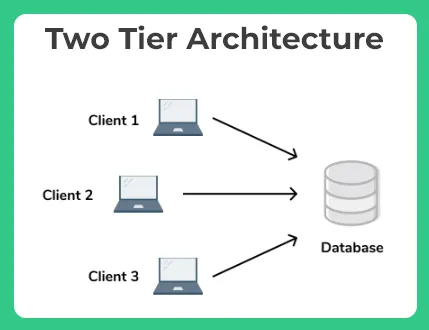2 Tier Architecture in DBMS
2 Tier Architecture
In a 2-tier architecture, the client and the server communicate directly with each other, and the client has direct access to the database. The client also includes the business logic and validation rules which can be executed in the client machine.
2 tier architecture in DBMS
On this page, we will learn about 2 Tier Architecture in DBMS.
- DBMS architecture plays a key role in the design, development, implementation, and maintenance of the database management system of the company
- The proper selection of database architecture will solve many design problems initially and also helps in quick and secured data access
- Any database management system uses any of the following to 2 architectures
- 2 tier architecture (two-level)
- 3 tier architecture (three-level)

Two Tier architecture
The two-tier architecture is similar to the basic Foundation model i.e client-server model.
Components of two tier architecture
It consists of two tiers
1. Client-side application:
-
- User interfaces and application programs run generally on the client-side
- It is generally a presentation layer that runs on a client (PC, Mobile, Tablet, etc)
- This client application establishes a connection by sending a request to the server-side up an application in order to establish communication between the database
2. Server side application
-
- The server side is responsible for query processing and transaction management
- In this, client-side directly communicates with the database base that is present on the server-side and the server sends a response to the request received from the client
- Simply server-side represented data is stored on a Server.
- Generally, APIS like ODBC, JDBC is used for this interaction i.e for sending requests from the client-side application.
Real-time examples for two-tier architecture
- Desktop applications excel sheets, word document, desktop games
- The contact management system that is created using MS Access is the most observed example is for this two-tier architecture.
Advantages of two-tier architecture
- As it is simple and easily understandable provides direct and faster communication
- Compatible with existing systems
- Provides some secretary to the DBMS as it is not directly e exposed to the end-user range.
Limitation of this two-tier architecture
It cannot be used for dynamic web applications where there are a large number of users and generally used for static desktop and small web applications.
Learn more about DBMS Architectures here on this page.
Prime Course Trailer
Related Banners
Get PrepInsta Prime & get Access to all 200+ courses offered by PrepInsta in One Subscription
Get over 200+ course One Subscription
Courses like AI/ML, Cloud Computing, Ethical Hacking, C, C++, Java, Python, DSA (All Languages), Competitive Coding (All Languages), TCS, Infosys, Wipro, Amazon, DBMS, SQL and others






Login/Signup to comment